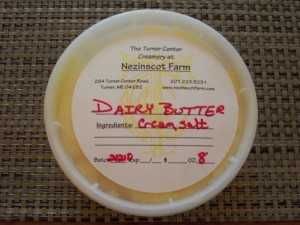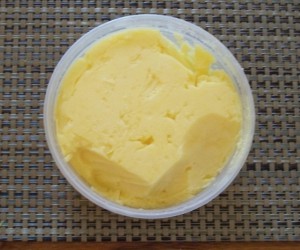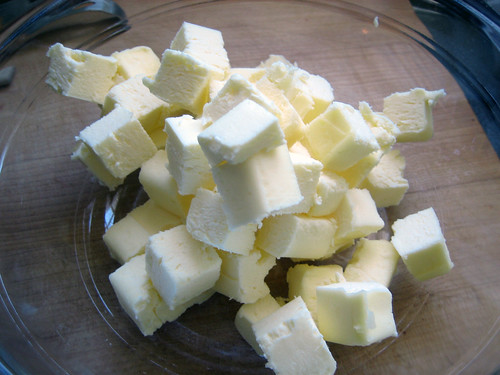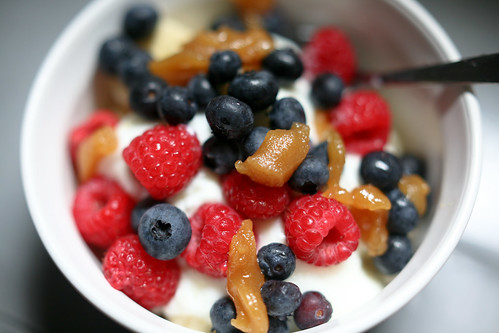Filed under: Nutrition
Today I wanted to show an example of why I think pasture-raised grass-fed products, dairy in particular, are so much different from their conventionally-raised counterparts.
Though I have blogged about the greatness that is Organic Valley Pasture Butter, now that I am home in Maine I have access to butter that I think is even better.
I purchase this butter at a farm stand in Leeds, ME near my parents camp (we call it a camp in Maine, most other people refer to it as a cottage). This butter is absolutely incredible. It tastes so incredibly buttery, for lack of a better word.

Just look at the color of it. It is a deep yellow, just bursting with so much more vitamin A, vitamin D, vitamin E, beta-carotene, omega-3′s, CLA and more than conventionally raised butter. I know that the Organic Valley Pasture butter has 8% of your daily value of vitamin A, 110 mg of CLA and 120mg of Omega-3′s per tablespoon, so I wonder what this has!

I also just love how the only two ingredients are cream and salt, no fillers or colors here. Unfortunately we ran out for a while and had to consume store-bought Kate’s butter.

Kate’s butter is an award-winning butter made fresh daily in Maine, but as far as I know the cows are not grass-fed, and the butter pales in comparison. It is a much, much lighter yellow, more like off-white, and just lacks that same intense butter flavor. Don’t get me wrong it is still good, just not nearly as good as the grass-fed version.

With less color you know it just has less of those ever-important fatty acids and fat-soluble nutrients that make butter a healthy food.
Isn’t the difference just striking? To me it just exemplifies how far our food production has fallen. Are they both butter? Yes. Are they nutritionally and deliciously equal? Hell No!
Just focusing on CLA, here is the difference. Dairy, and meat, from pasture-raised grass-fed animals provide the richest source of CLA on the planet, containing three to five times more CLA than feedlot-raised animals. CLA has been found to greatly reduce tumor growth in animals, and possibly in humans as well. In a Finnish study women who had the highest levels of CLA in their diet had a 60% lower risk of breast cancer than those with the lowest levels. Simply switching from conventionally-raised grain-fed meat and dairy to pasture-raised grass-fed versions would have placed all the women in the lowest risk category.
The fact of the matter is consuming foods how they were meant to be grown and developed will maximize nutrient density, so do your best to find local high-quality sources of food. Your body will thank you.
Filed under: General Health
I am actually at the Folger Library for my UMaine Graduate School Orientation as I write this quick blog. We had about an hour and a half for lunch, and as I am still conditioned to eating food as rapidly as possible from years of eating-while-coaching at CP, I had well over an hour to kill. So here I am.
Yesterday I wrote about the ridiculous accusations put forward by ABC News about creatine and its tenuous link to compartment syndrome.
Fortunately I am far from the only one who felt the need to clear the air on the topic. Chris Shugart over at T-Nation wrote a response that I must say might even be better than my own.
Check it out: ABC News Vilifies Creatine.
Filed under: General Health
A CP client just sent me an article on abcnews.com that asks the question “Did Creatine Lead to Compartment Syndrome Cluster?”
The article alleges that creatine may have caused 13 members of the McMinnville High School football team to be hospitalized with severe muscle problems.
This article is an example of absolutely awful sensationalist reporting. It makes it sound like 13 members of the team developed this rare Anterior Compartment Syndrome, when in reality only 3 developed it. Granted that is still an unusually high number, but it seems like a rather intentional misrepresentation of the facts to me. It also has a caption under a picture of these kids in the hospital, saying that 12 were admitted for severe muscle problems. The video states 14 players! So which is it, 12, 13, 14?
The reporter states that creatine has been linked to anterior compartment syndrome, but doesn’t provide any actual data or references, when in reality the link is tenuous at best.

In a 2006 double-blind, placebo-controlled, randomized, cross-over study (ie – the gold standard) at the University of Connecticut this theory was put to the test (free full text!). They placed 11 well-trained athletes through tests meant to mimic conditions in pre-season tryouts.
Subjects were put through two sessions, one 120 minutes, one 80 minutes, one hour apart. The subjects completed these sessions in over 90 degree heat in moderate humidity, causing approximately 4% loss in bodyweight. A 4% loss in bodyweight is a very significant amount. At just 2% bodyweight loss athletes performances can be decreased by up to 30% and experience rapid heart rates, elevated body temperatures, and rapid fatigue.
These subjects also consumed either 21.6 grams/day of creatine monohydrate or placebo for 7 days prior to the trials as this mimics the normal loading phase of creatine, which is usually 20-25 grams per day for 7 days. I will note that I personally do not recommend loading, as you can simply take 5 grams/day and reach the same saturation point in 28 days, so why waste product and money?
Anyway, back to the study. The researchers found:
“Our results show that short-term creatine monohydrate loading did not significantly increase resting anterior compartment pressure measures. However, creatine monohydrate did affect the anterior compartment pressure responses specific to dehydration, because a small to moderate effect was reported between pre-dehydration and post-dehydration anterior compartment pressure measures. Our data showed a greater increase in anterior compartment pressure in the creatine monohydrate trial than in the placebo trial at the post-dehydration time point. We also found that creatine monohydrate had an effect on the dehydrated subjects exercising in the heat, because a small to moderate interaction was reported between pre-dehydration and 1 minute post-heat tolerant test exercise for the trials. In addition, we discovered that creatine monohydrate supplementation caused a delay in the return of post-exercise anterior compartment pressure measures to resting values in these dehydrated subjects exercising in the heat.”
Uh oh, is creatine actually deserving of the blame? Lets keep reading to see the final conclusion.
“No evidence was observed in our study that short-term creatine monohydrate loading led to the signs and symptoms consistent with anterior compartment syndrome in a dehydrated athlete performing intense, intermittent, and prolonged exercise in the heat and humidity. None of the subjects in this study complained of lower extremity aching, cramping, burning pain, or tightness over the area of the anterior compartment of the lower leg, which is consistent with most of the literature.
High dose creatine monohydrate supplementation during exercise periods of increased thermal stress showed a mild to moderate trend toward increased anterior compartment pressure measures in dehydrated males. However, our results do not support the American College of Sports Medicine’s recommendation (to avoid creatine in hot environments), because no associated symptoms of anterior compartment syndrome were seen. The differences were minimal, and the increased pressures readily equalized after intermittent exercise.”
Hhmmm, so a sterling study that mimics intense two-a-days in 90 degree heat and moderate humidity found that (large) creatine supplementation did mildly increase the anterior compartment pressure (though it quickly returned to baseline), but it did not actually cause anterior compartment syndrome nor any even any of its symptoms!
Anterior compartment syndrome almost always occurs in the lower legs, and is often caused by severe over-use of the tissues. These athletes had the problems in their triceps, which is strange in and of itself. For the tissues in the triceps to develop that type of pressure, the training had to play a role.

Most of the experts interviewed for the article actually pointed the finger at the over-training that must have occurred for this syndrome to develop. Yet creatine gets the blame?
These athletes had just begun their training camp under a new head coach on Monday with symptoms being reported by Tuesday! No it couldn’t have anything to do with a new head coach trying to instill discipline and physically exert these kids into the ground. High school football coaches never do that! It must be the creatine!
Sarcasm aside, could creatine have contributed? Sure, especially if these high school kids were taking amounts outside the recommended doses then it might have made a small contribution, but the cause? I think not. I tend to lean towards the overzealous training myself.
It just drives me nuts how reporters like this know that claiming that over-training high school athletes may have lead to anterior compartment syndrome is not as sexy nor as provocative as stating that a nutritional supplement caused it.
While there are a lot, and I mean a lot, of shitty supplements out there that high school kids feel compelled to take, there are also a lot of good ones. Plain, high quality creatine monohydrate is the most studied supplement in history, and it has a sterling track record. If it really is such a dangerous substance, how do hundreds of thousands, probably even millions of athletes take it without also developing anterior compartment syndrome?
The literature has noted that the only consistently documented side effect of creatine supplementation is bodyweight increase! This is one of the primary purposes of supplementing with it!
What about the possibility that these kids did take creatine, but a poor one, with who knows what else in it that contributed to this issue? I think that is very likely knowing the nature of high school kids wanting to take the most “extreme” supplements that will get them insta-jacked.


What sounds better to a high school football player: Sodium Creatine Phosphate Matrix and Creatinol-O-Phosphate-Malic Acid Interfusion, or Creatine Monohydrate Powder?
Is the blame really on creatine monohydrate itself? I don’t think so, and a better reporter would have made it clear that the link is tenuous at best, used a less sensationalized title, and maybe actually gathered more data before pointing any fingers.
On an interesting aside, Dr. Donald Christie was one of the experts interviewed who said that creatine is most likely not the cause. Dr. Christie works in my home town of Lewiston, Maine and I know him quite well. Of course he also tossed the word bugaboo into his quote, making us Mainers look even more awesome.
Filed under: Nutrition
Today at the grocery store I came across something new and interesting next to my unsweetened almond milk (in the refrigerated section). It was coconut milk in a carton!

This was a timely discovery as a friend of mine just learned that he has an intolerance to almonds and most tree nuts in general, and as such had to give up using almond milk in smoothies, cereal and oatmeal. This is rather unfortunate as he tries to keep his dairy intake minimal, and he obviously avoids soy milk (cause it sucks) and rice milk due to its fiber-less and unnecessary carbohydrate content.
Instead of those more common options, he made the transition to unsweetened vanilla hemp milk without complaint as it is quite good, as well as being nice and creamy. It also contains more fat than almond milk, so it not only replaces the fluid in his smoothies, it also replaces the healthy fat content provided by the nuts he can no longer consume. The only downside to hemp milk is the price!
Hemp milk is about twice as expensive as almond milk. Hemp milk provides a good dose of healthy fat, including almost a gram of omega-3′s (including the rare SDA) and the healthy omega-6 GLA, it also contains protein, vitamins and minerals. It is a high quality replacement for almond milk, but you pay for it for sure.

Fortunately this ready to drink coconut milk is very reasonable priced, about equal to almond milk. It is also low in calories at only 50 per serving for the unsweetened version. Coconut milk also contains a good amount of fat like hemp milk, so it also serves that dual purpose.
It’s fatty acid content is almost completely saturated, with most of that being made up of the unique medium chain fatty acids. These MCFA’s (or MCT’s if you like, more or less the same thing) do not require bile for digestion, have immune-boosting benefits and are more likely to be oxidized as energy than stored as fat.
While I still might place hemp milk above coconut milk, as I think its nutritional profile is superior, coconut milk does provides a wonderful alternative for those who are seeking dairy free, soy free, nut free “milk” at a reasonable price.
Enjoy!
Here is more fleshed out content on the health benefits of hemp and coconut.
Filed under: Nutrition
I have to work in Lewiston all day today with for my old man, so unfortunately I have to make this one short and sweet, but that doesn’t mean that it is light on some cool content.
I actually have some pretty exciting news that I am quite pleased to announce today.
1. I am sure a lot of you read Eric Cressey’s blog and are a part of his newsletter. Those of you who are undoubtedly heard about his new project, Show and Go.
I had the privilege of being at CP when Eric tested the program on some guinea pigs, including a good friend of mine from college who increased his deadlift by 40lbs in 4 months (to 405), so I know how well the training program works.
The best part about all this is that Eric wanted a stronger nutrition component to go along with Show and Go than he had for Maximum Strength, and he asked me to write it! Keep in eye out over the next month or so for the release of Show and Go, my very first product!
2. I have discovered that making my oatmeal with unsweetened vanilla almond milk is absolutely glorious. I had always been a water man myself since I microwave my old-fashioned oats (it is the one and only thin I use the microwave for), and I definitely didn’t want to microwave milk due to the 7-keto cholesterol creation.
Earlier this week I was in the mood for some oatmeal, saw the almond, decided to do a little experimenting, and it was awesome. Give it a try and let me know what you think!

3. A reader sent me a question a while back about the quality of goat milk protein. Those of you who struggle with cow’s milk, or who simply choose not to consume it or any of it’s products often have limited options for protein powders. Goat milk can often be a viable option for you, as it is usually well tolerated by people with sensitivity to cow’s milk.
Fortunately a company called Mt. Capra has come up with what appears to be a solid alternative to cow’s milk proteins. While I haven’t personally tried them, their Caprotein and Double Bonded Protein seem to be high quality products, full of high quality protein (15-20 grams per serving), and the Double Bonded Protein is quite reasonably priced for a rather unique item.
For those of you in the market for an alternative to cow’s whey, give it a try and let me know what you think!

Filed under: Recipes
Today’s recipe comes from a CP client and friend of mine, Danny. Danny is a crazy busy guy with three young kids, a high-stress job, an hour-long commute each way and a near fanatical training intensity. When lifting, he straight up scares people.
He also loves to eat healthy, but he has minimal time to make 5-course gourmet meals, so he is pretty good at coming up with quick and tasty meals that are made up of delicious real foods.

Though I have used this picture before, it is just to awesome to not use again
This recipe he described to me as simple and delicious, with a little kick. After trying it, I have to agree. For those of you who eat healthy or desire to do so, here is another arrow in your quiver to help combat those urges to just order a pizza and call it a night.
Simple and Delicious…With a Kick
- 4oz lean ground turkey
- 4oz lean grass-fed ground beef
- 1 tbsp chopped garlic
- 1/4 cup chopped pepperoncini
- 1 cup chopped kale
- little bit of olive or coconut oil for cooking
- season to taste with sea salt, Mrs. Dash, and pepper
Directions - cook!
Filed under: General Health, Training
This past weekend I paid a little visit to CP. It was nice to see some friendly faces, do some coaching, catch up with the staff and get in a brutal 20 minute Prowler push medley (after doing some other strong man work).
I hate the Prowler, and I hate EC for programming that the day I come down. I could hardly move my legs for about 10 minutes after finishing they were so exhausted and full of blood.

After driving back home to Maine that evening (a shade under 3 hours) I played and walked 18 holes of some ugly golf at Poland Spring Golf Course the next morning. It was a beautiful day, though there were some very strong winds that made some shots quite interesting.
It was the first time I had ever played a links-style course, and I can’t say I was a huge fan. The pin placements were brutal, especially with the lack of rain so the greens were incredibly fast. I won’t even discuss my score, suffice to say that out of the four of us, at least I came in second. Walking 18 holes is always much more tiring than I expect, and as long as you are slugging down a 6-pack on the way, is some pretty good exercise. On an interesting aside, the Poland Spring Golf Course was the first golf course built at a resort in the US.

The following day my wife and I went whitewater rafting with my parents and sisters on the Kennebec River. Minus the fact that it was overcast and actually somewhat cold, it was fun as hell and I always enjoy crashing down a raging river and hitting some big rapids.
It was also quite fun to see both of my sisters, my mom and my wife fall out, while my dad and I managed to hold strong and actually stay in the raft. We went with Crab Apple Whitewater for those possibly interested in the experience. They do a great job and they have the best location due to the fact that as soon as you exit the river you merely toss your raft up on a trailer and then walk across the road directly to their base. All other companies you have to get back on a school bus and travel back to the base, some as far as 45 minutes away.
All in all it was a busy weekend, but definitely fun and active. A point it really drove home for me was you don’t have to just go to the gym to get some exercise, there are tons of opportunities just waiting for you outside your door! Even the training session at CP was something that really could have been done just about anywhere. You can flip tires, carry heavy stuff for long distances, smash stuff with a sledgehammer, drag heavy tires for time and more to get in a fun, varied and intense conditioning session in. Not everything has to be bench presses and curls!
Take advantage of this beautiful summer before the cold days of winter keep you bundled up inside. Though there is always snow-shoeing.
Filed under: General Health, Nutrition
So today I was simply planning on writing about one of my new favorite grocery store finds – hybrid fruits. I will get to those in a moment, but something was brought to my attention this morning that was so earth-shatteringly (is that even a word?) stupid I was at a loss for words.
Nate Tipilady, the guy you see beating up EC with the Graston tools on EC’s website, sent me this article from sciencedaily.com. The article essentially states that scientists have determined that taking a daily statin will off-set the cardiovascular disease risk increase associated with fast-food consumption. Due to this false assumption, they recommend that statins should be given away for free at fast food restaurants like condiments!

After reading the entire article I was prepared to write an absolutely scathing retort to all of the bullshit spewed in it. Fortunately Stephan over at wholehealthsource did it for me, and essentially took the words right out of my mouth. I highly encourage you to read the article and then read Stephan’s response, as he sheds some light onto the false statements, and points out that it is so ridiculous, he hopes that the authors are just being facetious. I for one surely hope so.
- Note - Stephan is actually responding to the editorial in the American Journal of Cardiology that the article was based on, not the article itself.
Below are my two favorite points that he makes about the editorial.
- “They assume the risk of heart attack conveyed by eating fast food is due to its total and trans fat content, which is simplistic. To support that supposition, they cite one study: the Health Professionals Follow-up Study (2). This is one of the best diet-health observational studies conducted to date. The authors of the editorial appear not to have read the study carefully, because it found no association between total or saturated fat intake and heart attack risk, when adjusted for confounding variables. The number they quoted (relative risk = 1.23) was before adjustment for fiber intake (relative risk = 1.02 after adjustment), and in any case, it was not statistically significant even before adjustment. How did that get past peer review? Answer: reviewers aren’t critical of hypotheses they like.
- Statins mostly work in middle-aged men, and reduce the risk of heart attack by about one quarter. The authors excluded several recent unsupportive trials from their analysis. Dr. Michel de Lorgeril reviewed these trials recently (3). For these reasons, adding a statin to fast food would probably have a negligible effect on the heart attack risk of the general population.”
Anywho, back to the original blog for today, the amazing and delicious hybrid fruits.
I had seen some of these fruits in the supermarket before, but had never tried one. A few weeks ago when camping with my long-time friends on the beautiful Saco river one of them was eating a pluot, and said it was absolutely fantastic.

A pluot is a pretty complicated fruit hybrid that has many varities created over generations of cross-breeding. The pluot is not to be confused with the plumcot, which is a simple plum and apricot hybrid and is a 50-50 split between the two.
A pluot is a cross between a plumcot and another plum, and so can be anywhere from 60-40 to 75-25 plum to apricot. This second cross-breeding allows for a lot of different varieties and makes the fruit sweeter than a plumcot.
Either way they looked juicy and sweet and really intrigued my wife and I. So of course when we returned home we bought and tried some, and I must say, they are absolutely awesome. They combine the best parts of a plum and an apricot, are sweet but not overlyso, high in fiber, potassium and antioxidants.

A week or so later we came across a variety that was called a Mango Tango pluot. This was a pluot that was supposed to have a slight mango taste to it. While the mango taste was rather mild, the pluot itself was incredibly juicy and delicious.
The next time you are in the grocery store, do yourself a favor and pick up some pluots to keep your fruit intake varied and interesting. I promise you won’t be disappointed.
Filed under: Nutrition, Recipes, Training
Though I am very happy to have moved back to Maine, and I love my grocery store, unfortunately it comes with one drawback.
They do not carry my usual 2% plain Greek yogurt. They only have fat free. This sucks because I am believer that full-fat dairy is better for you than fat free (and yes I realize that 2% isn’t full fat, but full fat Greek yogurt contains 46 grams of fat in my usual 2 cup serving, a bit much really).
So I have had to alter my yogurt consumption, and below is a simple and delicious recipe that I concocted that I think is superior to my previous yogurt meal anyway.
Since it is not Greek yogurt I am using I am able to afford the organic kind from grass-fed cows, go full fat since it contains a much more reasonable amount, and it contains more probiotics since Greek yogurt is more acidic and they die faster in that environment. I also add whey protein powder to increase the protein content, and whey provides a ton of its own immune boosting and health improving benefits to boot.

not exactly it, but close enough to give you the idea
It also provides all of the tremendous health benefits of berries, healthy fat and fiber from chia and some nuts, is easy to make and portable as well. For those of you who claim to be poor cooks or don’t have time to prepare meals, this is about as easy as it gets, so no more excuses!
I have used this recipe as breakfast, a mid-day snack or as a pre or post workout meal. For breakfast and pre or post workout I do add 1/2 cup dry old-fashioned oats to the recipe.
Sweet Cream & Berries
- 1.5 cups Cream Top Plain Stonyfield organic yogurt
- 1 scoop vanilla whey protein powder
- 1/2 cup (ish) wild blueberries
- 1/2 cup (ish) raspberries
- 1 tbsp chia seeds
- 2 tbsp almonds and pecans
- optional – 1/2 cup old-fashioned oats
Just stir the protein powder and chia seeds in with the yogurt, then add the fruit and nuts and enjoy! It is sweet and creamy with a little bit of crunch.

This provides approximately:
- Calories without oats – 566, with oats – 721
- Fat without oats – 26, with oats – 29
- Carbs without oats – 47, with oats – 74
- Fiber without oats – 12, with oats – 16
- Protein without oats – 36, with oats – 41
On a side note, I just ordered Muscle Imbalances Revealed this morning as the product looks absolutely incredible, and it has gotten great (and honest) feedback from a lot of top people in the industry. Since I am no longer at CP, products like this are so much more important for me. If you are a trainer or someone just truly interested in how your body works and how to fix yourself, check out Muscle Imbalances Revealed.
Filed under: General Health, Movie Review
I have some neat stuff to blog about today. It isn’t in any particular order, just some interesting things that I wanted to tell you guys.
1. I am heading down to CP this coming Saturday. I will be there all day from 9-2, coaching and helping out. If you are in the area come get a lift in, it will be a good time.
2. I saw Inception this weekend. All I have to say is it was absolutely mind-blowing. The creativity of Chris Nolan is astounding. How do people come up with stories like that?

The story was fascinating, the acting excellent, the direction and visual effects spot on. It did drag just a little in a few spots for me, but overall an A.
On the same note my wife and I were talking about it after we saw it, and I mentioned how it was one of those rare movies that immediately after you see it you want to watch it again because you know there are so many more details you will pick up the second time around, and you will enjoy it just as much, like the first time I saw The Matrix or The Usual Suspects.
She mentioned that she had never seen The Matrix, which absolutely blew my mind. So of course we immediately sat down to watch it, and I must say as much as I love that movie, it is amazing how the its visual effects have aged.
I hope that the critical and commercial success of Inception causes Hollywood to start making more movies like this, creative thinking-man movies rather than recycling the same shit over and over again.
3. I had one of the best nights sleep of my life last night. Like I mentioned the other day I use a dawn simulator to wake up naturally. One of my readers mentioned that his favorite function of those clocks is the dusk simulator that will slowly darken the room, mimicking the sunset rather than the sunrise to help you fall asleep.

I had never used that function before, so I decided to give it a try. It was glorious. I passed out as the light decreased and when I woke with the light of the dawn simulation (before the alarm) I thought it was the sunset turning off! I had slept so soundly that I hadn’t moved an inch all night. I woke up fresh and rested.
It makes me love my dawn simulator even more, and I can’t recommend it enough to help you fall asleep and wake up as we were meant to.
So some random tidbits from my life, but I thought it was some pretty interesting stuff.


























Posted on August 31st, 2010 by Brian St. Pierre
2 Comments »